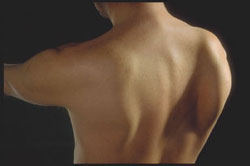What is a Winging Scapula?
 A winging scapula is a shoulder injury or condition in which the scapula or shoulder blade sticks out at the back, particular when lifting the arm up or pushing against something. Often patients complain of pressure on the shoulder blade from the back of their chair when sitting.
A winging scapula is a shoulder injury or condition in which the scapula or shoulder blade sticks out at the back, particular when lifting the arm up or pushing against something. Often patients complain of pressure on the shoulder blade from the back of their chair when sitting.
What are the symptoms of a winged scapula?
- Winging of the scapular or shoulder blade.
- Pain and limited shoulder elevation.
- Difficulty in lifting heavy objects.
What causes a winging scapula?
A winging scapula is associated with damage or a contusion to the long thoracic nerve of the shoulder and / or weakness in the serratus anterior muscle. If the long thoracic nerve is damaged or bruised it can cause paralysis of the serratus anterior muscle and winging of the scapular or shoulder blade.
Damage to the nerve can be caused by a contusion or blunt trauma of the shoulder, heavy weight lifting, repetitive throwing, traction of the neck or can also sometimes follow a viral illness. Some cases of long thoracic nerve injury are of unknown origin.
Treatment
Your surgeon will arrange nerve conduction studies to help assess the extent of damage to the long thoracic nerve and plan appropriate treatment.
Physiotherapy
A full rehabilitation programme aimed at re-educating the serratus anterior muscle can be successful when damage to the long thoracic nerve is mild. However, treatment can take 6 to 12 months to achieve a good outcome.
Surgery
If nerve conduction studies confirm that there is marked damage to the long thoracic nerve your surgeon may suggest an operation called a long thoracic nerve decompression to help the nerve recover. Current evidence shows that long thoracic nerve decompression results in good or excellent results in 92% of cases.
You will have a small incision approximately a hands breadth down from the middle of your armpit. This will allow your surgeon to access and decompress the affected nerve.
What are the risks of having a long thoracic nerve decompression?
All operations involve an element of risk, these are very small but you need to be aware of them and can discuss them with your doctor at any time.
The risks are;
- Complications relating to the anaesthetic
- Infection (less than 1%)
- Stiffness and or pain around the shoulder (less than 1%)
- Damage to nerves or blood vessels around the shoulder

